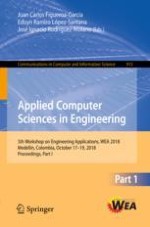2018 | Book
Applied Computer Sciences in Engineering
5th Workshop on Engineering Applications, WEA 2018, Medellín, Colombia, October 17-19, 2018, Proceedings, Part I
Editors: Prof. Juan Carlos Figueroa-García, Eduyn Ramiro López-Santana, José Ignacio Rodriguez-Molano
Publisher: Springer International Publishing
Book Series : Communications in Computer and Information Science
